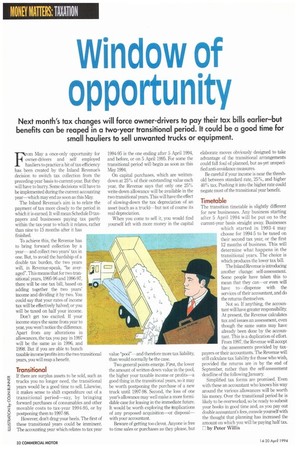Window of opportunity
Page 38

If you've noticed an error in this article please click here to report it so we can fix it.
Next month's tax changes will force owner-drivers to pay their tax bills earlier—but benefits can be reaped in a two-year transitional period. It could be a good time for small hauliers to sell unwanted trucks or equipment.
F. om May a once-only opportunity for owner-drivers and self employed hauliers to practice a bit of tax-efficiency has been created by the Inland Revenue's decision to switch tax collection from the preceding-year basis to current-year. But they will have to hurry. Some decisions will have to be implemented during the current accounting year—which may end as soon as this May.
The Inland Revenue's aim is to relate the payment of tax more closely to the period in which it is earned. It will mean Schedule D taxpayers and businesses paying tax partly within the tax-year to which it relates, rather than nine to 15 months after it has finished.
To achieve this, the Revenue has to bring forward collection by a year— and collect two years' tax in one. But, to avoid the hardship of a double tax burden, the two years will, in Revenue-speak, "be averaged". This means that for two transitional years, 1995-96 and 1996-97, there will be one tax bill, based on adding together the two years' income and dividing it by two. You could say that your rates of income tax will be effectively halved; or you will be taxed on half your income.
Don't get too excited. If your income stays the same from year to year, you won't notice the difference. Apart from any alterations in allowances, the tax you pay in 1997 will be the same as in 1996, and 1998. But if you are able to bunch taxable income/profits into the two transitional years, you will reap a benefit.
Transitional
If there are surplus assets to be sold, such as trucks you no longer need, the transitional years would be a good time to sell. Likewise, it makes sense to shift expenditure out of a transitional period—say, by bringing forward purchases of consumables and other movable costs to tax-year 1994-95, or by postponing them to 1997-98.
However, don't drag your heels. The first of these transitional years could be imminent. The accounting year which relates to tax year 1994-95 is the one ending after 5 April 1994, and before, or on 5 April 1995. For some the transitional period will begin as soon as this May 1994.
On capital purchases, which are writtendown at 25% of their outstanding value each year, the Revenue says that only one 25% write-down allowance will be available in the two transitional years. This will have the effect of slowing-down the tax depreciation of an asset (such as a truck)– but not of course its real depreciation.
When you come to sell it, you would find yourself left with more money in the capital
value "pool"—and therefore more tax liability, than would normally be the case.
Two general points erne*. First, the lower the amount of written-down value in the pool, the higher your taxable income or profits—a good thing in the transitional years, so it may be worth postponing the purchase of a new truck until 1997-98. Second, the loss of one year's allowance may well make a more formidable case for leasing in the immediate future. It would be worth exploring the implications of any proposed acquisition—or disposal— with your accountant.
Beware of getting too clever. Anyone is free to time sales or purchases as they please, but elaborate moves obviously designed to take advantage of the transitional arrangements could fall foul of planned, but as-yet unspecified anti-avoidance measures.
Be careful if your income is near the threshold between standard rate, 25%, and higher 40% tax. Pushing it into the higher rate could negate most of the transitional year benefit.
Timetable
The transition timetable is slightly different for new businesses. Any business starting after 5 April 1994 will be put on to the current-year basis straight away. Businesses which started in 1993-4 may choose for 1994-5 to be taxed on their second tax year, or the first 12 months of business. This will determine what happens in the transitional years. The choice is which produces the lower tax bill.
The Inland Revenue is introducing another change: self-assessment. Some people have taken this to mean that they can—or even will have to dispense with the services of their accountant, and do the returns themselves.
Not so. If anything, the accountant will have greater responsibility At present, the Revenue calculates tax and issues an assessment, even though the same sums may have already been done by the accountant. This is a duplication of effort. From 1997, the Revenue will accept the assessments provided by taxpayers or their accountants. The Revenue will still calculate tax liability for those who wish, provided the returns are in by the end of September, rather than the self-assessment deadline of the following January.
Simplified tax forms are promised. Even with these an accountant who knows his way around the various allowances will be worth his money. Over the transitional period he is likely to be overworked, so be ready to submit your books in good time and, as you pay out double accountant's fees, console yourself with the thought that planning has increased the amount on which you will be paying half tax. Fl by Peter Willis


























































































